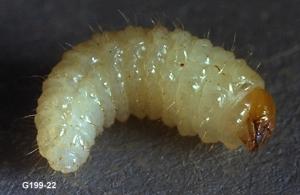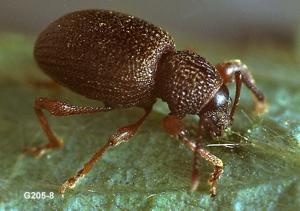|
Return to:
[Strawberry Root
Weevil Identification]
[Insect
Management]
[Home]
|
|
Strawberry Root Weevil Larva
Strawberry Root Weevil Adult
The immature or larval stage of the strawberry root weevil causes damage to
mint by feeding on roots. However, it has become obvious that the best way to control this
pest is in mid-June or early July with a foliage spray to kill the adults applied in the
evening (after sunset for best success).
Sampling:
SRW larvae are best estimated by taking 1000 cm² soil samples after harvest in late
August and September or the following spring in March, April or early May. In western
Oregon, samples for root weevils may be combined with samples for mint root borer. In
central Oregon, they may be combined with samples for redbacked cutworm in April and May.
Take at least 25 soil samples from different areas of the field (one site per 2 1/2
acres), screen the soil, count the number of larvae and calculate the average number per
sample. If the average number of root weevil larvae exceeds two per sample, treatment of
adults with an insecticide is recommended (or see below for the treatment threshold which
includes the total larvae, pupae, and adults/1000 cm²).
A sequential sampling program has been developed for SRW in central Oregon (Cacka, 1982). This sampling plan is based on taking a minumum of 25,
1000 cm² soil samples and accumulating the number of adults, pupae, and larvae found in
each sample. Using this method, treatment is recommended if the total accumulated number
of adults, pupae, and larvae exceeds 5.5 weevils/1000 cm². Treatment is not recommended
if the total weevils/sample is less than 2.7/1000 cm². These values vary with the cost of
treatment and the price of mint oil. To generate new thresholds and sequential sampling
plans based on current values, run the sequential
sampling calculator.
All SRW are females capable of laying eggs without fertilization. In general there is a 2-
week period before the females begin laying eggs after emergence from the soil. This
biological fact helps time an insecticide application for optimum control when most of the
adults have emerged from the soil, but prior to any egg laying. In practice, mint fields
suspected of being infested with SRW should be sampled with a sweep net in the evening a
couple of hours after sunset. Still, warm and dry evenings are best. Windy, cool and/or
rainy periods produce fewer weevils per sweep, giving the impression of a smaller field
population than is actually present. Take 10 straight line sweep samples in at least five
different sites in fields up to 30 acres. Add one additional sample site for each
additional 10 acres.
Even though no treatment threshold has been developed for adult SRW, we have seen that,
once an infestation becomes established in a field, it can be difficult to control. An
evening application of an insecticide against adults may be justified even if the
population is at a relatively low level. If treatable populations occur, an insecticide in
the evening after 90 to 100 percent of the adults have emerged, and prior to egg laying in
June or early July. Weevils will not have mature eggs in their bodies until about 2 weeks
after emergence (Cacka, 1982). Therefore, monitor for the presence
of eggs in the weevils by collecting five or ten adults and, after squashing their bodies,
inspecting for small round yellow eggs through a 15x hand lens. If you spray too soon,
there will be a residual population of weevils emerging post-spray to lay eggs. If you
spray too late, egg laying will have already occurred. Field observations indicate that
two applications of an insecticide may be required in central Oregon, but only one West of
the Cascade Mountains.
Using parasitic nematodes to control strawberry root weevil:
The parasitic nematode, Steinernema
carpocapsae, provides control of strawberry root weevil larvae in mint. For best
results, applications should be injected through sprinkler irrigation after harvest in the
evening or at night at a rate of 3.0 billion juvenile nematodes per acre. Applications of
parasitic nematodes applied post-harvest will control both strawberry root weevil larvae
and mint root borer larvae. Applications to control strawberry root weevil in the spring
have been less successful largely because of low soil temperatures (< 60oF). Therefore,
additional research is required to establish proper timing of applications for SRW control
in the spring. Parasitic nematodes also may be used to control mint flea beetle and mint
root borer.
Biological Control:
A carabid beetle, Pterostichus vulgaris, found in western and central
Oregon mint fields, feeds on strawberry root weevil adults, pupae, and larvae and may
substantially reduce the population (Cacka, 1982). However,
populations of this important predator may be significantly reduced by summer applications
of insecticides used for adult strawberry root weevil control. |


